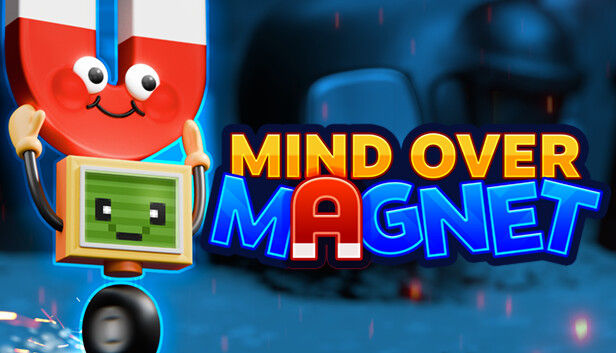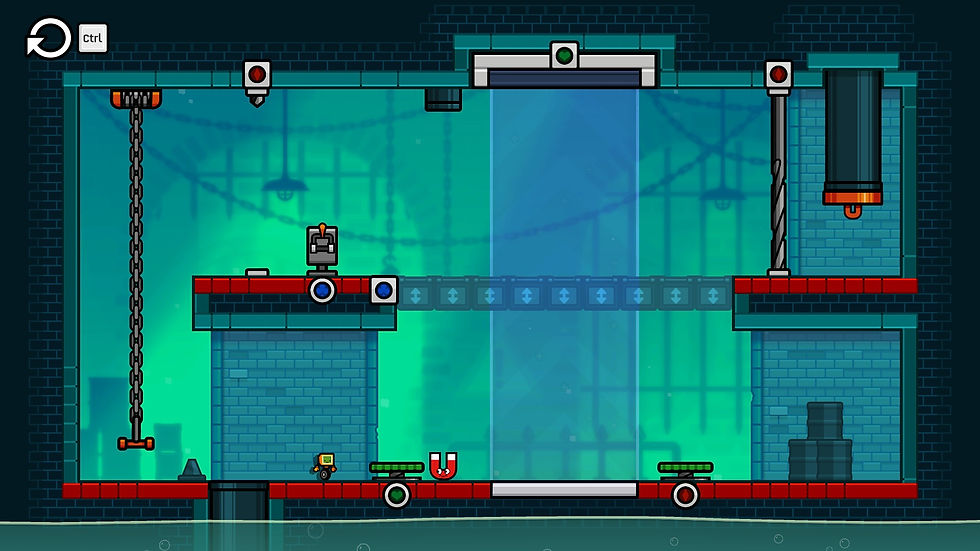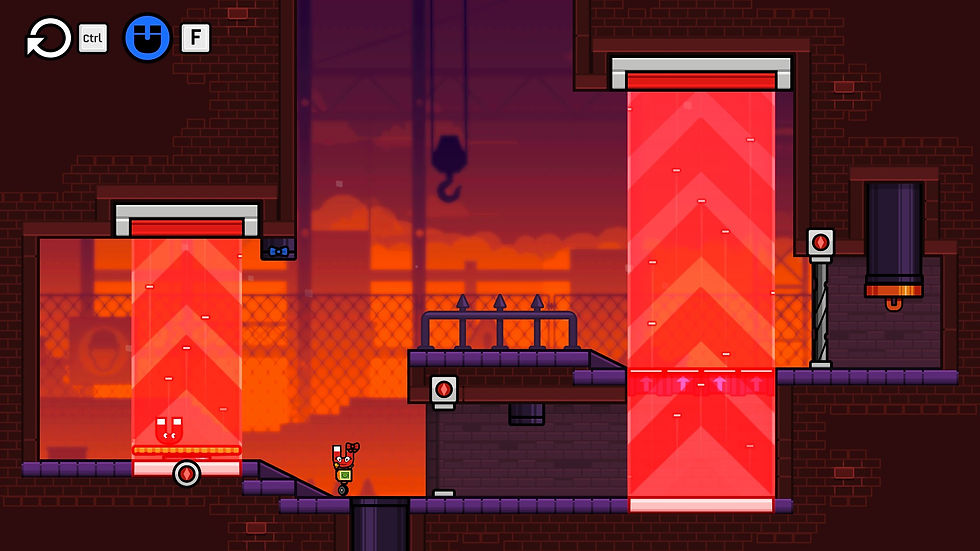Mind Over Magnet: Mag Net-Positive
- Jonathan Frankel
- Nov 20, 2024
- 6 min read
Updated: Nov 21, 2024
by: Jonathan Frankel

Image credit: Game Maker's Toolkit
For more than a decade now, Mark Brown, a.k.a. Game Maker’s Toolkit (GMTK), has been making videos diving deep into game design, level design, the do’s and don'ts of player engagement, mechanics, production, and much more. They’re slickly presented, well researched, sharply written, and easily digestible to the average layperson. As far as YouTubers go, he’s among my personal favorites—I practically drop everything to gobble up his videos as soon as they pop into my feed.
It feels like just a few months ago that Brown announced he’d be developing a video game of his own, chronicling his journey into the intimidating world of development and sharing lessons learned along the way with the audience. In reality, it’s been three years. The relentless march of time strikes again! From teaching himself Unity, consulting with acclaimed composer Austin Wintory on how to describe what you want your game to sound like, to scrapping the game altogether and starting over from scratch, I’ve greatly appreciated his transparency in communicating the ups and downs of game development from the perspective of a first-timer. Three years of iteration, playtests, reiteration, demos, and the support of family and friends (and thousands of Patreon supporters) has resulted in Mind Over Magnet, a charming little puzzle platformer that proves Brown can put what he preaches into practice.
Of course, none of this means anything to you if you aren’t familiar with GMTK. As a fan, I undeniably went into this game with a rare bias, rooting for its success from day one which is something I wouldn’t typically do with the same fervor for an unknown developer. But even without all that baggage, Mind Over Magnet delivers on the promise of a great puzzler, albeit a barebones one.

Image credit: Jonathan Frankel / Game Maker's Toolkit
You play as Uni, a determined little robot CRT on wheels, er, one wheel, hence the name. I loved how despite being nonverbal, Uni adorably expresses their emotions through the fuzzy visage of their monitor. It’s the best kind of character design, minimalistic, yet unique and easily identifiable through silhouette. Same goes for Magnus, the first companion Uni meets on their adventure. A classic red U-shaped magnet head with a big, dumb grin on its face, Magnus is essentially Mind Over Magnet’s mascot and gleefully guides the player through the game’s opening levels, teaching you all the basic laws of attraction as it were. Along the way, Min and Max join the party, the two sisters representing positive and negative polarity—I’ll let you figure out which is which. Min’s negative outlook is reflected in her apathetic demeanor while Max’s jubilant personality type more closely aligns with Magnus’. Once you discover the factory’s sinister intentions it’s up to the intrepid fellowship to make their great escape. Yeah, it’s not the deepest story. No thematic undertones of grief or depression to be found here. But with what little story the game offers, it serves as a perfectly good enough excuse for some mind-bending puzzles.

Image credit: Jonathan Frankel / Game Maker's Toolkit
With your newfound magnet buddies in tow, you’ll navigate the factory by clearing increasingly complicated puzzles putting your polarity problem-solving skills to the test. Like any good puzzle game, the difficulty ramps up gradually but consistently. Mechanics stack on top of each other at a pace which always kept me on my toes, yet never overwhelmed me, and it does a great job of squeezing the juice out of almost every idea before moving on to something new. At first, you’ll be flipping switches to turn a highlighted area’s magnetism on and off, drill bits that emerge and retract from walls, bounce pads that launch our heroes to new heights, and many more, sometimes all at once.
In later levels, there are often enough switches and pressure plates that all activate different things to make your head spin. Luckily, Brown implemented an effective solution to make it easy for the player to keep track of what activates what. Playing card symbols are cleverly used to indicate switches corresponding to specific environmental effects, so a spade symbol appears above a laser, and another spade symbol is used to indicate the lever that turns it on/off. Same goes for a diamond-symboled magnetic field connected to a pressure plate of the same suit. You get the idea. A quality-of-life feature as simple as that is what I believe takes this from a decent game to a great one, as it makes it painless for the player to wrap their head around what they’re looking at without compromising the difficulty of the puzzle itself.

Image credit: Jonathan Frankel / Game Maker's Toolkit
Actually, there are a whole host of accessibility options to make beating the game doable for anyone. There are colorblind options that change the colors of the suits, you can change the colors indicating positive and negative polarity, and if you really want, you can turn the background into a blank grid, enhancing the level’s foreground readability. You can request a hint from the cheeky “Stuck?” menu on the pause screen, which places an outline suggesting where Uni should be standing or where Magnus should be placed without telling the player the solution outright. There’s even an option to completely skip the level, though it’s tied to a countdown timer encouraging players to at least try before giving up entirely. GMTK’s myriad videos covering the topic of accessibility/assist modes clearly paid off here, and I’ll always advocate for more of these options in games.

Image credit: Jonathan Frankel / Game Maker's Toolkit
Each room feels carefully designed to lull the player into a false sense of security upon entering the level, preying on hasty assumptions that lead to incorrect solutions (Brown basically confirms as much in the unlockable developer commentary feature). I was impressed by how consistently nearly every level made me reevaluate the order of operations two or three times before inevitably finding the correct solution. It can feel like little more than trial and error at times, but even failure can feel rewarding when you discover what not to do. What doesn’t feel as great, is the fact that you can fairly often find yourself soft-locked if you mess up and do things in the wrong order. Levels can quickly be restarted with no load times by holding down the left bumper (ctrl on mouse+keyboard) for a couple seconds, so it's barely even worth mentioning. I can’t begin to fathom how difficult good level design is to create, especially for a puzzle-platformer, so I’m willing to give it a pass, but I’d be lying if I said I didn’t feel a bit disappointed when I made a mistake and the only way out was to reload.
My only other disappointment was in the solution to one of the final levels—the first level in World 5, specifically. Not that it was particularly brain busting, but it commits the cardinal sin of asking the player to do something they were never taught. Up to this point, the game was so good about introducing a concept, either via gameplay or dialogue, and then building upon that system naturally. Here, it asks you to use Magnus, Min, and Max in ways not previously established. It ended up being the only puzzle where I had to use the aforementioned hint system, and even then it took me longer than it should have to find the solution. Then again, it’s (very) possible that I’m just stupid and nobody else will have this problem!

Image credit: Jonathan Frankel / Game Maker's Toolkit
Minor gripes aside, Mind Over Magnet is a brilliant debut title from one of my favorite YouTubers and evidence that Brown’s years discussing game design wasn’t just talk. The entire experience took me around 3 hours to complete, and an additional 2 hours for another playthrough with developer commentary on. There are no collectibles to find, hidden bonus levels, concept art, secret achievements, or anything like that. It’s all killer and no filler, and you could do a lot worse for ten bucks. Hopefully, this is the start of a long, fruitful game dev career for GMTK, but if not, it’s not only a fascinating side project, but an attractive little puzzle game in its own right.
Final Rating: 8/10

Image credit: Game Maker's Toolkit



Comments